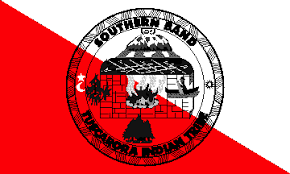The Tuscarora know as the "hemp gatherers" or sometimes as the "Shirt-Wearing People" are a Native American tribe and Iroquois Six Nations band government of the Iroquoian-language family. Today they have members residing in New York, USA, and Ontario, Canada. They coalesced as a people around the Great Lakes, likely about the same time as the rise of the Five Nations of the historic Iroquois Confederacy, also Iroquoian-speaking and based then in present-day New York.
Well before the arrival of Europeans in North America, the Tuscarora had migrated south and settled in the region now known as Eastern Carolina. European explorers first encountered the Tuscarora people on land later incorporated into the colonies of North Carolina and Virginia. After the 18th-century wars of 1711–1713 (known as the Tuscarora War) against English colonists and their Indian allies, most of the surviving Tuscarora left North Carolina and migrated north to Pennsylvania and New York, over a period of 90 years. They aligned with the Iroquois in New York, because of their ancestral linguistic and cultural connections. Sponsored by the Oneida, they were accepted in 1722 as the Sixth Nation of the Iroquois Confederacy, or Haudenosaunee. After the American Revolution, in which they and the Oneida allied with the colonists, the Tuscarora shared reservation land with the Oneida before gaining their own. The Tuscarora Nation of New York is federally recognized.
Those Tuscarora who allied with the British in the American Revolution resettled with other Iroquois tribes in present-day Ontario, where they are part of the Six Nations of the Grand River First Nation. Only the tribes in New York and Ontario have been recognized on a government-to-government basis by the respective national governments. After the migration was completed in the early 18th century, the Tuscarora in New York no longer considered those remaining in North Carolina as members of the tribal nation.
